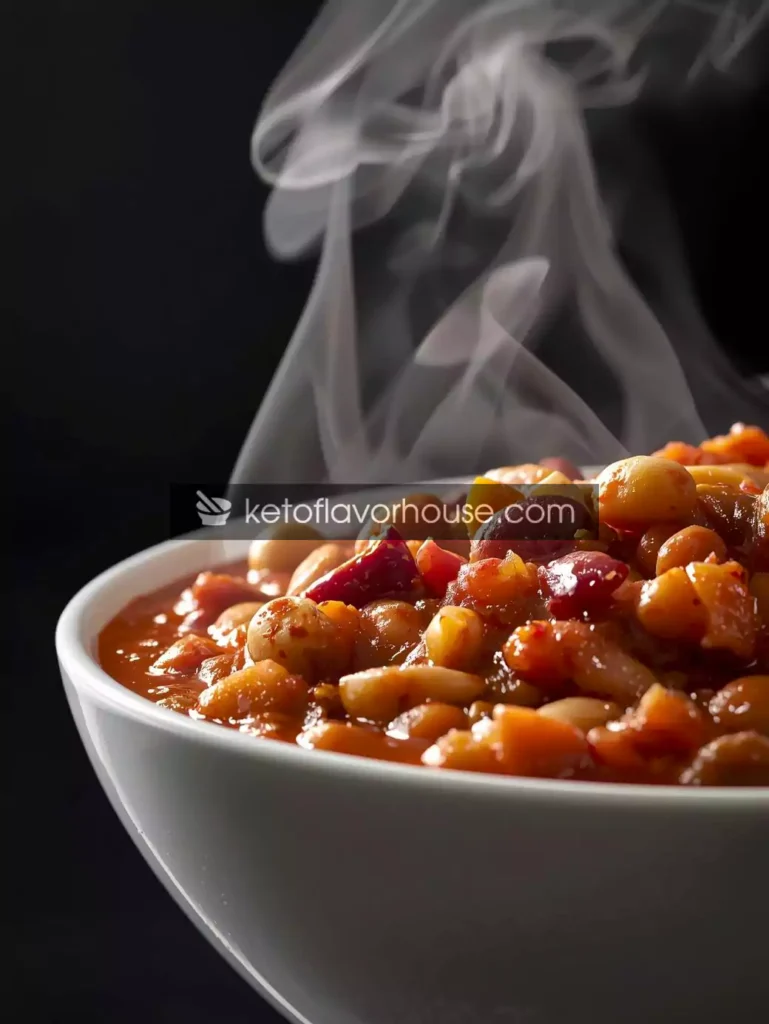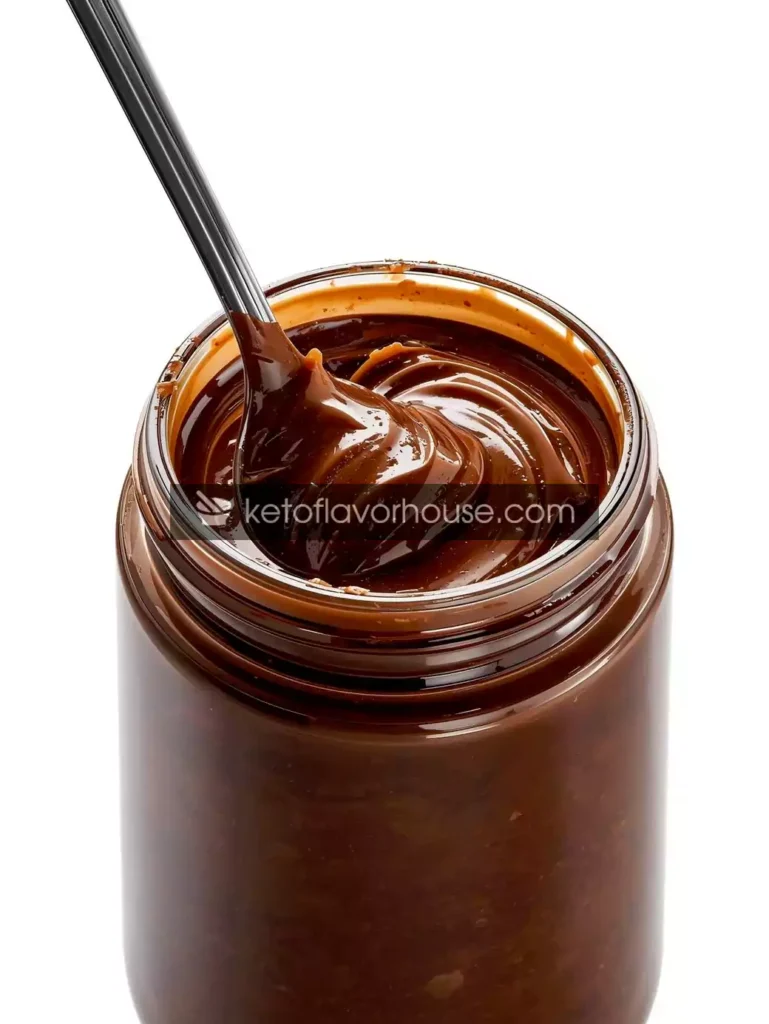This post may contains Amazon affiliate and other affiliate links. If you make a purchase through these links, I may earn a small commission at no extra cost to you. Your support helps me continue to provide quality content. I only recommend products I personally trust and believe will add value to your experience. For more details, please visit my Privacy Policy.
Introduction
There are few dishes that warm you from the inside out like a bowl of well-made chili. After my bariatric surgery, I missed those slow-simmered, belly-warming meals more than I expected — but I also knew I needed meals that focused on protein, portion control, and gentle digestion. That’s why I created this Bariatric Spicy Vegetarian Chili: a smoky, satisfying pot of comfort that still respects a bariatric plan. This Chili is intentionally high-protein and low-calorie, using lentils, black beans, and a few smart swaps to deliver hearty texture and real satiety without the heavy cost of excess calories or oversized portions.
From the first spoonful you’ll notice the layers: a faint smoky edge, bright tomato tang, and a soft, lentil-driven body that holds its shape without feeling heavy. It’s the kind of recipe that proves you can have cozy, spicy, soul-soothing food after surgery — and still hit your protein targets. If you love bold flavors, like to meal-prep, or want a family-friendly dish that doubles as excellent leftovers, this recipe is for you.
Why You’ll Love This Recipe
- 🌶️ Big, smoky flavor with carefully controlled heat.
- 🍲 High-protein thanks to lentils + beans — keeps you fuller, longer.
- 🥦 Low-calorie & nutrient-dense — veggies and fiber-rich legumes do heavy lifting.
- ⏱️ One-pot comfort — easy weeknight or make-ahead meal.
- 👨👩👧 Family-friendly — serve with different toppings so everyone customizes.
My Personal Experience
My first attempt at a vegetarian chili after surgery was a disaster: too bland, watery, and frankly, unsatisfying. I wanted the smoky, slightly charred flavor of a classic chili but without the fat and portion overload. After a few test pots — adding a touch of smoked paprika here, stirring in tomato paste there, testing lentils for body — I landed on this formula. I remember the moment I ladled a bowl, sprinkled a tiny swirl of plain Greek yogurt on top, and watched the steam curl into the air. The first bite had everything I’d been chasing: warmth, depth, and a fullness that didn’t leave me groggy. That “aha” bowl turned this from a curiosity into a weekly staple.
Required Equipment
Large Heavy-Bottomed Pot or Dutch Oven
A thick-bottomed pot gives even heat for simmering without scorching. You want the chili to bubble slowly, not slam against a thin pan.
Wooden Spoon or Heatproof Spatula
For stirring without scratching cookware. A spoon with a long handle keeps your knuckles away from steam.
Measuring Cups & Spoons
Precision matters in bariatric cooking — especially when portioning protein and tracking calories.
Ladle & Bowls
For serving and portion control. Using the same ladle helps keep servings consistent.
Ingredients & Substitutions
(Makes about 6 main-course servings)
- 1 cup dry red lentils (≈192 g)
Why it matters: Lentils are lean, filling, and a powerful vegetarian protein source that cooks down into a creamy-but-textured body for the chili.
Substitution: Red split lentils are ideal; if you only have brown/green lentils, they’ll work but take longer to cook. - 1 cup cooked black beans (≈172 g) — rinsed and drained if canned
Why it matters: Adds fiber, texture, and plant protein while keeping the chili hearty without meat.
Substitution: Cannellini or pinto beans can be used; for fewer carbs, replace with extra lentils or cauliflower rice. - 1 can (14 oz/400 g) crushed tomatoes
Why it matters: Provides acidity and body. The natural sweetness balances the spice.
Substitution: Fresh tomatoes blended in a pinch, or passata. - 1 medium onion (≈110 g), finely diced
Why it matters: Aromatics build flavor without fat. Onions add natural sweetness as they soften.
Substitution: Use shallots for a milder profile. - 1 medium red bell pepper (≈120 g), diced
Why it matters: Color, vitamin C, and a crisp contrast to the softer lentils.
Substitution: Green or yellow peppers will work. - 2 garlic cloves, minced
Why it matters: Boosts savory depth — garlic is small but mighty.
Substitution: ½ tsp garlic powder. - 1 tbsp tomato paste (≈16 g) (I use 2 tbsp total in the pot for extra umami)
Why it matters: Concentrated tomato flavor and a touch of caramelized sweetness that deepens the chili.
Substitution: A splash of reduced-sodium soy sauce or miso for extra umami if needed. - 1 tbsp olive oil (≈14 g)
Why it matters: Small amount of healthy fat to sauté aromatics and help flavor bloom.
Substitution: Use a non-stick spray and reduce oil to 1 tsp for fewer calories. - 4 cups low-sodium vegetable broth (≈960 g)
Why it matters: Keeps the pot flavorful while controlling sodium.
Substitution: Water plus an extra pinch of spices if broth isn’t available. - 1 tsp smoked paprika, 1 tsp ground cumin, ½ tsp chili powder, pinch of cayenne (optional), salt & pepper to taste
Why it matters: These spices create the warm, smoky backbone without added calories. - Optional garnish: ¼ cup nonfat Greek yogurt, chopped cilantro, lime wedges, or 2 tbsp shredded reduced-fat cheddar (for those who tolerate dairy).
Why it matters: A spoon of Greek yogurt adds protein and cooling contrast to the spice; small amounts go a long way.
How to Make Bariatric Spicy Vegetarian Chili
Step 1 — Sauté the Base Aromatics
Heat the olive oil in your pot over medium heat. Add the onion and bell pepper, sauté until softened and slightly golden (about 5–7 minutes). Stir in the garlic for 30 seconds until fragrant. This step builds the flavor foundation — don’t rush it.
Mini-tip: If you’re cutting calories, reduce oil and add a splash of broth to prevent sticking.
Step 2 — Brown & Bloom the Spices
Stir in smoked paprika, cumin, chili powder, and a pinch of cayenne. Toast for 20–30 seconds to activate the spices’ aroma, then add tomato paste and cook another minute to remove the “raw” tomato edge.
Mini-tip: Toasting spices for just a few seconds multiplies their depth.
Step 3 — Add Lentils, Beans & Liquids
Add the dry red lentils, cooked black beans, crushed tomatoes, and vegetable broth. Stir, bring to a gentle boil, then reduce to a simmer. Cover and cook 18–22 minutes, stirring occasionally, until lentils are tender and the chili has thickened.
Mini-tip: If the chili seems too thick, add a splash of broth; too thin, uncover and simmer a little longer.
Step 4 — Final Seasoning & Finish
Taste for salt and heat. Fold in a small handful of fresh cilantro if desired. For extra creaminess, stir in 2 tbsp Greek yogurt or top each bowl when serving.
Mini-tip: Letting the chili sit off-heat for 10 minutes helps flavors marry and reduces immediate saltiness perception.
Slow Cooker Variant
Sauté aromatics on the stove, then add everything to the slow cooker and cook on low for 4–6 hours. Lentils can become softer in slow-cooker; check texture toward the end.
Instant Pot Variant
Sauté the onions and spices using the SEAR function, add ingredients, seal and pressure cook for 8 minutes, quick release, and adjust thickness with sauté if needed.
Common Mistakes to Avoid
- Adding spices too late: They need a moment in oil to bloom — otherwise flavor stays flat.
- Skipping the tomato paste step: This small step gives depth; add it and cook briefly.
- Overcooking lentils to mush: Red lentils break down faster; check at 18 minutes. If you want chunkier texture, use brown lentils and adjust cook time.
- Not tasting before serving: Chili benefits from a quick salt and acid adjustment (lime or vinegar).
Pro Tips for Best Results
- Use low-sodium broth and control salt yourself; it’s easier to add than remove.
- For a smoky backbone, smoked paprika is more important than liquid smoke — it’s easier to control.
- If you crave chewiness, stir in a small handful of chopped mushrooms midway for meaty texture.
- Portion into single-serving containers immediately for easy reheats and controlled portions.
Bariatric Nutrition & Strategy
This chili centers on plant proteins (lentils and beans) which supply steady protein and fiber. For bariatric eaters, protein is essential for healing and preserving lean mass; fiber helps with fullness and digestive regularity. Because capacity is limited after surgery, small but protein-focused meals like a modest bowl of this chili help you feel satisfied without overeating. Pair this chili with a small side of lean dairy (Greek yogurt) or a 2–3 ounce portion of grilled chicken if you need extra protein that day.
Variations You Can Try
- Lentil-forward (lower carb): Reduce beans to ¼ cup and add more lentils.
- Smoky chipotle: Add one minced chipotle or 1 tsp adobo for smokier heat.
- Mediterranean twist: Omit chili powder and add oregano, lemon zest, and a dollop of plain yogurt.
- Protein boost: Stir in crumbled firm tofu or 1 cup cooked quinoa for additional protein.
Each tweak changes carb and protein balance slightly — adjust portion sizes to fit your stage and targets.
Tips for This Recipe
- Serve in a shallow bowl to encourage slower eating and smaller bites.
- Start with ½ cup portions if you’re early post-op, and eat protein first.
- Brighten with acid (lime) at the end — it awakens flavors so smaller portions feel more satisfying.
Optional Additions
- Chopped avocado — healthy fats, use sparingly.
- Reduced-fat shredded cheese — small sprinkle for melty comfort.
- Sliced green onion & cilantro — freshness without calories.
Serving Ideas
- Meal prep: Divide into 6 single-serve containers for grab-and-reheat lunches.
- Family dinner: Serve with whole-grain crackers or a side salad for others; keep yours focused on the soup bowl.
- Potluck: Top with small bowls of garnishes so guests build their own.
Storage Recommendations
- Fridge: Keeps well for 4 days in an airtight container.
- Freezer: Freeze in single portions for up to 3 months. Thaw overnight and reheat gently.
- Reheating: Warm over low-medium heat, adding a splash of broth if needed to loosen.
Frequently Asked Questions (FAQ)
1. Can I freeze this chili?
Yes. Portion into freezer-safe containers and thaw overnight in the fridge before reheating. Texture holds up well.
2. Is this suitable early after bariatric surgery?
Not in the immediate liquid/pureed stages. As you progress to soft solids and protein-focused meals, small portions are appropriate — consult your dietitian about timing.
3. Can I replace lentils with tofu for protein?
Yes, firm tofu works well stirred in toward the end for extra protein and a different texture.
4. Will the chili be too spicy for me?
No — reduce or omit cayenne and chili powder for milder heat. You’ll still have smoky flavor from paprika.
5. How do I increase protein further?
Add a scoop of unflavored protein powder stirred in after cooking (check flavor), or top with plain Greek yogurt and a handful of crumbled grilled chicken if tolerated.
6. What if I can’t tolerate beans?
Replace with extra lentils or cauliflower rice; beans add fiber but are replaceable.
7. Is this low-calorie?
Yes — it’s built to be nutrient-dense but relatively low in calories per serving, making it friendly for weight loss and bariatric diets.
Nutritional Breakdown (Per Serving)
(Approximate — recipe yields 6 servings)
- Calories: ≈ 233 kcal
- Protein: ≈ 16.85 g
- Fat: ≈ 3.38 g
- Total Carbs: ≈ 34.72 g
- Fiber: ≈ 14.20 g
- Net Carbs: ≈ 20.51 g
- Sugar: ≈ 6.43 g
- Sodium: ≈ 343 mg
These values are estimates based on the ingredient quantities listed and are useful for tracking portions and protein goals.
Recipe Snapshot
- Prep Time: 10 minutes
- Cook Time: 25 minutes
- Total Time: 35 minutes
- Course: Main / Soup
- Cuisine: Comfort / Tex-Mex inspired
- Servings: 6
- Calories (per serving): ≈ 233 kcal

Bariatric Spicy Vegetarian Chili (High-Protein & Low-Calorie Recipe)
Ingredients
- 1 cup dry red lentils 192 g
- 1 cup cooked black beans 172 g
- 1 can 14 oz/400 g crushed tomatoes
- 1 medium onion diced (110 g)
- 1 red bell pepper diced (120 g)
- 2 garlic cloves minced
- 2 tbsp tomato paste ≈33 g
- 1 tbsp olive oil 14 g
- 4 cups low-sodium vegetable broth 960 g
- 1 tsp smoked paprika 1 tsp cumin, ½ tsp chili powder, pinch cayenne, salt & pepper
- Optional: nonfat Greek yogurt cilantro, lime
Instructions
- Sauté onion and pepper in oil until softened (5–7 min).
- Add garlic, spices, and tomato paste; cook 1 min.
- Stir in lentils, black beans, crushed tomatoes, and broth.
- Bring to boil, simmer covered 18–22 min until lentils tender.
- Adjust seasoning, finish with cilantro and a dollop of Greek yogurt. Serve warm.









